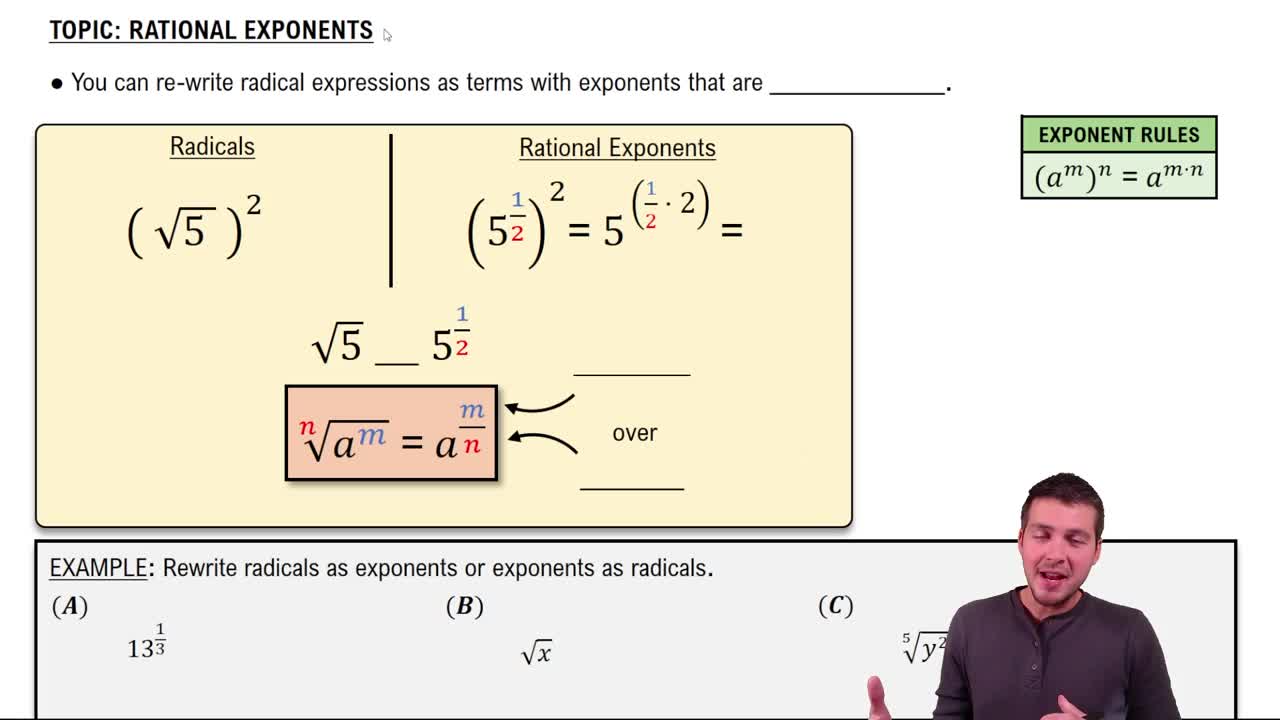Table of contents
- 0. Review of Algebra4h 16m
- 1. Equations & Inequalities3h 18m
- 2. Graphs of Equations43m
- 3. Functions2h 17m
- 4. Polynomial Functions1h 44m
- 5. Rational Functions1h 23m
- 6. Exponential & Logarithmic Functions2h 28m
- 7. Systems of Equations & Matrices4h 6m
- 8. Conic Sections2h 23m
- 9. Sequences, Series, & Induction1h 19m
- 10. Combinatorics & Probability1h 45m
1. Equations & Inequalities
Choosing a Method to Solve Quadratics
Problem 91b
Textbook Question
Solve each equation. See Examples 8 and 9. (x-1)^2/3+(x-1)^1/3 -12 = 0
 Verified step by step guidance
Verified step by step guidance1
Let us start by making a substitution to simplify the equation. Set \( y = (x-1)^{1/3} \). This means \( y^2 = (x-1)^{2/3} \).
Substitute \( y \) and \( y^2 \) into the equation: \( y^2 + y - 12 = 0 \).
Now, we have a quadratic equation in terms of \( y \). To solve it, we can use the quadratic formula: \( y = \frac{-b \pm \sqrt{b^2 - 4ac}}{2a} \), where \( a = 1 \), \( b = 1 \), and \( c = -12 \).
Calculate the discriminant \( b^2 - 4ac \) to determine the nature of the roots.
Once you find the values of \( y \), substitute back \( y = (x-1)^{1/3} \) to solve for \( x \) by cubing both sides and solving for \( x \).
Recommended similar problem, with video answer:
 Verified Solution
Verified SolutionThis video solution was recommended by our tutors as helpful for the problem above
Video duration:
6mPlay a video:
Was this helpful?
Key Concepts
Here are the essential concepts you must grasp in order to answer the question correctly.
Exponents and Radicals
Understanding exponents and radicals is crucial for solving equations involving powers and roots. In this equation, the terms (x-1) are raised to fractional exponents, which represent roots. For example, (x-1)^(2/3) indicates the square of the cube root of (x-1). Mastery of these concepts allows for proper manipulation and simplification of the equation.
Recommended video:
Guided course

Rational Exponents
Substitution Method
The substitution method is a powerful technique for simplifying complex equations. In this case, letting u = (x-1)^(1/3) transforms the original equation into a more manageable polynomial form. This approach can help reduce the complexity of the problem, making it easier to solve for x after finding u.
Recommended video:

Choosing a Method to Solve Quadratics
Polynomial Equations
Polynomial equations are expressions that equate a polynomial to zero. The equation derived from the substitution method will typically be a cubic polynomial, which can be solved using various methods such as factoring, synthetic division, or the Rational Root Theorem. Understanding how to work with polynomial equations is essential for finding the roots and solutions of the original equation.
Recommended video:
Guided course

Introduction to Polynomials

 4:03m
4:03mWatch next
Master Choosing a Method to Solve Quadratics with a bite sized video explanation from Callie
Start learningRelated Videos
Related Practice
